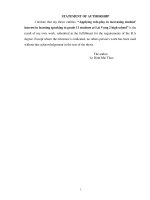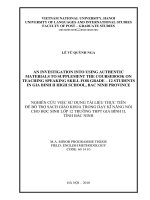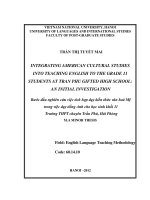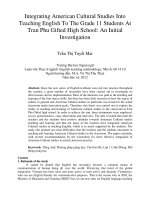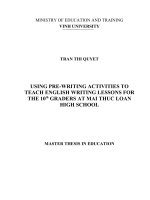USING SOME TECHNIQUES TO TEACH VOCABULARY EFFE CTIVELY TO GRADE 12 STUDENTS AT LE VIET TAO HIGH SCHOOL
Bạn đang xem bản rút gọn của tài liệu. Xem và tải ngay bản đầy đủ của tài liệu tại đây (100.97 KB, 14 trang )
THANH HOA EDUCATION AND TRAINING DEPARTMENT
LE VIET TAO HIGH SCHOOL
SEMINAR ON METHODOLOGY
USING SOME TECHNIQUES TO TEACH VOCABULARY
EFFECTIVELY TO GRADE 12 STUDENTS
AT LE VIET TAO HIGH SCHOOL
Teacher: Lê Thị Tuyến
Subject: English
THANH HOA, 2017
TABLE OF CONTENTS
Contents
Pages
ACKNOWLEDGEMENT...……………………………………………..
1
I. INTRODUCTION…………………………………………………......
2
I.1. Reasons for choosing the topic…………………………………….
2
I.2. Objectives of the study……………………………………………
2
I.3. Subjects of the study………………………………………………
2
I.4. Methods of the study………………………………………………
2
II. CONTENTS OF THE STUDY………………………………………
3
II.1. Rationale………………………………………………………...
3
II.1.1. What vocabulary to teach ?..................................................
3
II.1.2. Principles for teaching vocabulary ………………………
3
II.2. Situation before applying the study………………………………
4
II.3. Solutions to problems……………………………………………
5
II.3.1. Presenting vocabulary……………………………………
5
II.3.2. Checking vocabulary………………………………………
7
II.3.2.1. What to check?.........................................................
7
II.3.2.2. When to check?........................................................
7
II.3.2.3. How to check?..........................................................
7
II.4. The effectiveness of the study on teaching and learning…………
9
III. CONCLUSION AND REQUEST…………………………………...
10
BIBLIOGRAPHY…………………………………………………….....
11
ACKNOWLEDGEMENT
Firstly, I would like to express my sincere thanks to all the leaders of
Thanh Hoa Education and Training Department for organizing this seminar and
for giving me the precious chance to do it.
Secondly, I am very grateful to all the teachers of English at Le Viet Tao
high school for offering me useful advice in realizing my ideas.
Lastly, thank you very much for your presence and observation. Your
comments and advice would be highly appreciated.
1
I. INTRODUCTION
I.1. Reasons for choosing the topic
Vocabularies are simple enough to begin learning on the first day of a
class and they are powerful enough to encourage communication from the very
beginning. Words are small pieces of language which carry bits of meaning.
Knowing many words does not ensure that a person will be able to speak a
language, but not knowing words can prevent a person from effectively speaking
or understanding a language. That’s the reason why vocabulary must be taught
from the very start.
There are numerous vocabularies in English subject in high school.
Therefore, teachers must have the most effective method of teaching vocabulary
to present vocabulary effectively. A good method of teaching vocabulary will get
more students’ attentions. Inspired by this idea, I decided to choose the topic “
using some techniques to teach vocabulary effectively to grade 12 students”
to study.
I.2. Objectives of the study
When carrying out this study, I would like to show teachers of English
several principles for teaching vocabulary and to provide them with a range of
steps for teaching vocabulary as well.
I.3. Subjects of the study
During the study, I observe the way of learning of the 12 th grade students
and how teachers of English teach vocabulary at Le Viet Tao high school.
I.4. Methods of the study
In this study, I have used the following methods:
- Consolidating experiences
- Observing
- Consulting
- Interviewing
- Reading documents
- Conducting some surveys
- Studying students’products
2
II. CONTENTS OF THE STUDY
II.1. Rationale
II.1.1. What vocabulary to teach ?
As we know, there are two types of vocabulary. They are: Passive
vocabulary and active vocabulary.
Passive vocabulary are words which a student can recognize but not
necessarily use in speaking or writing. If a student sees a word in their passive
vocabulary, he/she will understand what it means. Passive vocabulary words are
especially useful for receptive skills of reading and listening.
Active vocabulary are words which students can both understand and use in
communication .Active vocabulary words are especially useful for the
productive skills of speaking and writing .
∗The process of vocabulary expansion looks something like this:
Unknown - > Passive vocabulary -> Active vocabulary
A teacher should expect his/her students to understand words in reading
and listening before they can use those same words in speaking and writing.
When teaching, it is best to first train students to recognize words. Later the
teacher will find the students can actively use those same words in
communication.
II.1.2. Principles for teaching vocabulary :
If teachers want students to remember new vocabulary, it needs to be
learnt in context, practised, and then revised to prevent students from forgetting.
Teachers must make sure students have understood the new words, which will
be remembered better if introduced in a "memorable way" (Hubbard et. al.
1983:50). Bearing all this in mind, teachers have to remember to employ a
variety of techniques for new vocabulary teaching.
- Provide a context for new words: We will help the students guess the
meanings of the new words and remember easilier.
- Do not present too much new words at once. Teach a few words and
allow students to practise and use them a lot. This will help them remember new
words easily.
- Practising new words in context is more important than memorizing
isolated words. Students may be required to learn the meanings of words but
3
they must also be given the opportunity to use them productively in speaking
and writing.
- Teach your students skills for guessing new words, especially when
reading. The meaning of words can be inferred from the different types of
contexts and from looking at affixes (parts) of the word.
- Avoid translation as much as possible. If the students are always having
words translated, they are really only communicating in their own language , not
in Eglish. Also, students do not usually remember vocabulary that has been
translated. Only use translation as a last resort, when it would otherwise take too
long to communicate in English.
- Avoid using the dictionary a much as possible. When reading or listening
,students should first try guessing or ignoring new words so that they can
continue without stopping. Also using a dictionary when speaking or listening
often slows down communication. In writing, using a dictionary can be
beneficial. It helps students express themselves more clearly.
- Practise the new words in context first, practise in chorus, and then
individually.
- Active words are needed to teach first, ignore the passive words.
Those are the principles for teaching vocabulary. Have you taught
vocabulary follow those principles? In my opinion, if all of us follow those
principles strictly, our students won’t find it difficult to remember new
vocabulary any more and we will get better feedback from our students.
II.2. Situation before applying the study
English is a compulsory subject at school and in the GCSE exam but
students, particularly grade 12 students, feel stressful to learn English. They find
many difficulties in learning grammar, pronouncing, especially in learning
vocabulary. They don’t have enough words to master reading, speaking,
listening and writing skills. They also have trouble in doing tests because of the
lack of vocabulary. Even they can’t find out any suitable methods to follow
when they want to concentrate on learning vocabulary. Therefore, they ignore
reading parts in tests or they complete reading parts without making sure that
which answer is correct although reading skill accounts for nearly half of the
mark in a test.
4
In addition, many teachers of English at high schools don’t spend enough
time on teaching vocabulary. They only pay attention to grammar or they still
use old methods when teaching news words. They get students to understand
and remember new words passively.
II.3. Solutions to problems
In this part of the study, I would like to focus on techniques used in
presenting and checking vocabulary.
II.3.1. Presenting vocabulary
When introducing a new word, teachers must give students a chance to
know the followings:
II.3.1.1. Present pronunciation: By reading words in context, emphasise it by
putting a stress on it.
II.3.1.2. Present dictation: Write new words on the board clearly and then helps
students copy them in their notebooks.
II.3.1.3. Present the meanings of new words: There are a variety of
techniques for communicating the meanings of words. However, I mainly use
the following ones to make students active and creative in learning.
1. Paraphrase and define: We can explain a word by using a different word,
words or a definition
Example: When teaching the word “goalie” in Unit 12 – Reading (English
12 – Education Publish House), I convey its meaning by giving students a
definition“ A goalie is a person who keeps the goal”
2. Drawing: We can draw a picture of some words on the board that will quickly
convey the meanings
Example: When teaching the word “vertical” in Unit 12 – Reading
(English 12 – Education Publish House), I convey its meaning by drawing a
goal.
VERTICAL
3. Realia and objects: When we teach abstract nouns in semantic fields, we can
bring a series of real objects to class.
Example: When teaching the word “letter of recommendation” in Unit 6 –
Reading (English 12 – Education Publish House), I bring a realia to class
5
4. Flash cards or charts: We can use flash cards or charts on which we have a
picture on one side and words on the other side
Example: When teaching the words “terrorism”, “labour-saving”, “spaceshuttle” in Unit 8– Reading (English 12 – Education Publish House), I have used
flash cards.
5. Mime and gestures: We can act out to demonstrate its meaning ( of course,
without saying )
Example: When teaching the word “punch” in Unit 12 – Reading (English
12 – Education Publish House), I mime andask students to guess the meaning.
6. Photogaphs and Pictures : We can use pictures to communicate about many
types of words.
Example: I have used many pictures to convey the meanings of the words
when teaching the words “flood, earthquake, epidemic, famine” in Unit 14 –
Reading (English 12 – Education Publish House)
7. Antonyms and synonyms: When students know a word we can give them the
antonyms or the synonyms
Example: When teaching the word “contaminated” in Unit 10 – Reading
(English 12 – Education Publish House), I get students to know the meaning of
the word by giving its synonym “polluted” and its antonym “clean”
8. Guessing from context : Have students guess the meanings by reading the
whole sentence.
Example: When teaching the word “enact” in Unit 10 – Reading (English
12 – Education Publish House), I help students to understand its meaning
through the context “Governments have enact laws to protect wildlife from
commercial trade and overhunting”
9. Guessing from stems and suffixes or affixes and stems : Meaning of some
words can be understood through affixes or suffixes
Example: When teaching the word “extinction” and “disappear” in Unit
10 – Reading (English 12 – Education Publish House), I analyse it and get
students to understand it
Extinct + ion = Extinction or disappear = dis + appear
II.3.1.4. Present the forms / functions / the uses
When teaching a new word, teachers should give the form of the word.
6
This helps students to do well not only questions in reading parts but also
questions related to word forms. I often make a sentence or a word phrase with
the new word, then ask students to give the form of the word or I ask students to
recognise the suffix of the word to know the functionof the word
Example: When teaching vocabulary in Unit 3: Ways of socializing –
Reading (English 12 – Education Publish House), I ask students to find out the
form of the words: verbal, attention, appropriate, acceptable, assistance by
looking at the ending of the word: al, ion, ate, able, ance.
II.3.2. Checking vocabulary
II.3.2.1. What to check?
After teaching vocabulary, every teachers should check their students on
vocabulary of pronunciation, dictation, using and meaning. If their students give
good feedbacks, it means they are successful in teaching vocabulary .
Therefore, vocabulary are needed to check. It means pronunciation,
dictation , using and meaning are needed to check.
II.3.2.2. When to check ?
In my opinion, After teaching vocabulary, we can check our students’
understanding vocabulary, or we can check in the end of the lesson as free stages
. But some teachers check vocabulary while students are practising language
skills . In short, we can check vocabulary at any stages of the lesson ,provided
that our students can understand and use vocabulary to make sentences and
practise language skills.
II.3.2.3. How to check ?
There are many ways of checking vocabulary mentioned in other studies.
They are considered as games: noughts and crosses, slap the board, wordsquare,
networks, hang man, shark attack, jumbled words, rub out and remember, what
and where, matching, etc.
To deal with this part, I would like to provide some new games I have
applied while teaching vocabulary to my grade 12 students.
Game 1: Car racing
This is an interesting game. It is a useful way to revise vocabulary
Procedures: ( Teachers may draw on the board ar prepare an extra board)
- Draw three lines to make two parallel racing roads and devide the racing
7
road into equal trangles
Example:
Racer I
run Tear
draw
eat
generous equip
Racer II
Hit Red
Race
willing temple
say
young
tear
no
perfect
gain
ray
- At first, teacher gives two starting words in two racing roads
- Then, tow racers have to write the next word beginning with the last letter
of the word from the racing road of the opponent
- The game ends when there is a racer who can’t write down the word
Note: For the beginners, teachers may get students to play at simple levels. And
teachers may have it played at complex levels (words relating the topic,
combined words) by advanced learners
Game 2: Word making
This is also a funny game for revising vocabulary and enriching
students’vocabulary
Procedures:
- Devide the class into two teams or play the game individually
- Teacher gives a word and asks students to make new words from each
letter. The winner is the one who makes more words than the others.
Example: when checking vocabulary in unit 1 (English 12 – Education
Publish House), I give the word “chores” and ask students to make new words
from the letters of the word.
Game 3: Sentence making
This game is a bit difficult but very interesting and it helps students to
practice not only vocabulary but also grammar.
Procedures:
- Devide the class into two teams or groups of 8
- Teacher gives a sentence including some words that teacher want to
check and asks students to make new sentences using the words in the given
sentence. Which team or group makes more sentences will be the winner
8
Example: when checking vocabulary in unit 15 (English 12 – Education
Publish House), I give a sentence: “women are often treated unequally to men”
and students have to make new sentences from the words of the sentence. Which
team can’t make a new sentence, that one will be the lost
Game 4: Being a dictionary
This is a useful game for checking vocabulary. However, it requires
students’ large vocabulary.
Procedures:
- Devide the class into two teams
- Teacher gives each team a word and asks each team to explain the word
in English. The other team has to tell the meaning of the word.
Example: when teaching new words in unit 3 (English 12 – Education
Publish House), I devide the class into two teams and give each team a word and
ask them to explain the word in English.
Teachers should use some of those games to check vocabulary. With new
text book series, if teachers use games to check vocabulary as well as other
skills, they will not only get the best feedback from their students but also make
classroom atmosphere always merry.
II.4. The effectiveness of the study on teaching and learning
The study has some certain effects on not only teachers and their teaching
but also students and their learning.
After using new techniques in teaching vocabulary, I and other teachers
in my school have had deep understanding that teaching voabulary is not a
tedious process but an interesting and active one.
Students feel motivated to learn vocabulary. They find it easier and more
exciting to remember new words. They are really active learners in many
lessonss. Vocabulary is not difficult to them any more. Their results in the exam
are much higher than those of the students in the class in which teachers don’t
use these techniques. Therefore, the study has an important part in improving the
quality of general education in my school.
III. CONCLUSION AND REQUEST
9
1. Conclusion
To sum up, vocabulary is very important and there are numerous ways of
teaching and learning vocabulary. Each teacher has her/his own way of teaching
vocabulary but the characteristics of teaching vocabulary are the same in any
languages. The final purpose of every teacher is to enlarge students’ vocabulary
in order to help them to be good listeners, speakers, readers, and writters in any
languages.
Techniques I have mentioned above are not all but not least. I hope they
will bring teachers and learners an effective way to master English.
2. Request
There are no private lessons for teaching vocabulary so it’s advisable for
teachers to use these games at the beginning to warm up the lesson or at the end
to consolidate the lesson. Teachers should combine these techniques flexibly to
have the best result.
The study is not perfect and mistakes are unavoidable because of limited
time and my inexperience. It needs lots of comments and ideas in order to be a
better one. Therefore, comments and remarks are welcome so that the subject
matter will be discussed more thoroughly.
School Leaders’ confirmation
Hoang Hoa, May 16th 2017
Hereby, I certify that the study is the result of
my own research.
Lê Thị Tuyến
BIBLIOGRAPHY
1. Khan, J (1991) Using Games in Teaching English to Young Learners
10
2. Brumfit, C and Johnson, K (1987) The Communicative Approach to
Language Teaching. Oxford University Press
3. Global Education Website
4. Violet website
11
DANH MỤC
CÁC ĐỀ TÀI SÁNG KIẾN KINH NGHIỆM ĐÃ ĐƯỢC HỘI ĐỒNG
ĐÁNH GIÁ XẾP LOẠI CẤP SỞ GD&ĐT VÀ CÁC CẤP CAO HƠN
XẾP LOẠI C TRỞ LÊN
Họ và tên tác giả: LÊ THỊ TUYẾN
Chức vụ và đơn vị công tác: Giáo viên Tiếng Anh trường THPT Lê Viết Tạo
TT
1
2
3
Tên đề tài SKKN
Sử dụng một số phương pháp để dạy
phần “production” trong quá trình dạy
kỹ năng đọc hiểu cho học sinh lớp 11
Một số kỹ thuật sửa lỗi trong quá
trình dạy kỹ năng viết Tiếng Anh cho
học sinh THPT
Nâng cao hiệu quả giảng dạy các tiết
học Tiếng Anh cho học sinh lớp 11
thông qua việc đổi mới kiểm tra
miệng
Cấp
đánh
giá xếp
loại
Sở GD
& ĐT
Kết quả
đánh
giá xếp
loại
C
Năm học
đánh giá
xếp loại
2008-2009
Sở GD
& ĐT
C
2009-2010
Sở GD
& ĐT
C
2012-2013


